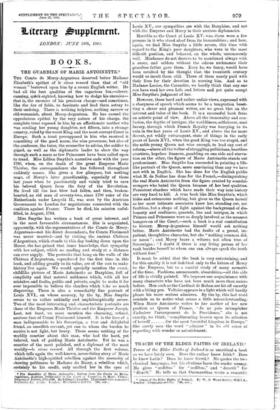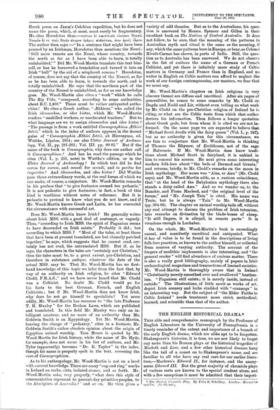TRACES OF THE ELDER FAITHS OF IRELAND"
Traces of the Elder Faiths of Ireland is as uncritieal.a book as we have lately seen. Does the author know Irish? Does he know Latin? Does he know Greek? He.quotes the two classical languages, but his citations leave the reader uneasy. He gives "aedebus" for " acdibus," and " decavit" for " dicavit." He tells us that Onomacritus wrote a romantic • Traces of She Rider Faiths of Ireland. By W. G. Wood-Martiu, London : Longman and Co. Ms. net.] Greek poem on Jason's Colchian expedition, but he does not name the poem, which, at most, must surely be fragmentary. He cites Herodotus thus :--zotran, 712 zartmEpei axiom Nwpol. Noupiar ai r0 ..rpO; Bo* aif OY iptuo; 'Apo' zwy, Ogoy iyhei; Rum The author then says :—" In a sentence that might have been penned by an Irishman, Herodotus thus mentions the Neuri : Still more remote are the Neuri, whose country, towards the north as far as I have been able to learn, is totally uninhabited." Did Mr. Wood-Martin translate this text him- self, or has he borrowed a translation and turned' it into an Irish " bull" by the aid of a misplaced comma ? Herodotus, of course, does not say that the country of the Neuroi, as far as he has been able to learn, is towards the north, and is totally uninhabited. He says that the northern part of the country of the Neuroi is uninhabited, as far as our knowledge goes. Mr. Wood-Martin also cites a " work " which he calls The Rig Vida, "composed, according to some authorities, about B.C. 2,400." These must be rather antiquated autho- rities ! He cites a Greek author, " /Ethicus," who called the Irish ideomochos, or ideo histas, which Mr. Wood-Martin renders "unskilled workers, or uneducated teachers." But to what language are we to assign ideomochos and ideo histas ? "The passage is from a work entitled Cosniographiam..Jthici Istrii," which in the index of authors appears in the decent guise of " Cosmographia Jthici Istrii, ab Hieronymo, ed. Wuttke, Lipsiae, 1854; see also Ulster Journal of Archaeo- logy, Vol. IL, pp. 281-282 ; Vol. III. pp. 80-81." But if the name of the book is Cosmographia, why does our author call it Cosmographiam. ? And has he read the passage which he cites (Vol. I., p. 251, note) in Wuttke's edition, or in the Ulster Journal of Archaeology ? In which text did he find corem for eorum, and muudi for mundi, and in peritos for imperitos? And ideomochos, and ideo histas ? Did Wuttke pass those extraordinary words, at the real forms of which we can make, of course, a conjecture. Mr. Wood-Martin remarks in his preface that " to give footnotes seemed too pedantic." It is not pedantic to give footnotes ; in fact, a book of this kind is worthless without notes of reference. But it is pedantic to pretend to know what you do not know, and if Mr. Wood-Martin knows Greek and Latin, he has concealed the circumstance with successful art.
Does Mr. Wood-Martin know Irish ? He generally writes about Irish MSS. with a good deal of contempt, or vaguely.
Thus, "according to Irish MSS. the spirit of Paganism seems to have descended on Irish saints." Probably it did ; but according to which MSS. ? "Most of the tales, at least those that have been at present translated, are but clumsily patched together," he says, which suggests that he cannot read, cer- tainly has not read, the untranslated MSS. But if, as he says, the characters in the tales are "certainly not Christian," then the tales must be, to a great extent, pre-Christian, and therefore in substance antique, whatever the date of the actual MSS. may be. That Mr. Wood-Martin has no first- hand knowledge of this topic we infer from the fact that, by
way of an authority on Irish religion, he cites "Edward Clodd, F.R.A.S.," and we have never heard that Mr. Clodd was a Celticist. No doubt Mr. Clodd would go for his facts to the best German, French, and English Celticists ; but if Mr. Wood-Martin does not know Irish, why does he not go himself to specialists ? Yet more oddly, Mr. Wood-Martin has recourse to "the late Professor T. H. Huxley " for the Brehon Laws, which are published and translated. In this field Mr. Huxley was only an in- telligent amateur, and no more of an authority than Mr. Goldwin Smith is on Egyptology. Yet Mr. Wood-Martin, braving the charge of pedantry," cites in 'a footnote Mr. Goldwin Smith's rather obsolete opinion about the origin of Egyptian animal worship. Tom Moore is quoted by Mr. Wood-Martin for Irish history, while the name of Dr. Hyde, for example, does not occur in his list of authors, and Mr. Tylor (apparently) becomes " Dr. E. Taylor" in the index, though his name is properly spelt in the text, reversing the case of Cosmographiam.
As to his anthropology, Mr. Wood-Martin is not on a level with current knowledge. There are many "cup and ring" marks in Ireland on rocks, cists, isolated stones, and so forth. Mr. Wood-Martin asks, very properly, " what does this style of ornamentation represent to present-day primitive peoples, to the Aborigines of Australia?" and so on. He then gives a
variety of odd theories. But as to the Australians, his ques- tion is answered by Messrs. Spencer and Gillen in their excellent book on The Natives of Central Australia. It does not follow, to be sure, that the meaning of the patterns in Australian myth and ritual is the same as the meaning, if any, which the same patterns bore in Europe, or bear, as Colonel Rivett-Carnac has shown, in parts of India. Still, the ques- tion as to Australia has been answered. We do not observe in the list of authors the name of a German or French Celticist, and yet there is infinitely more study of Celtic matters in Germany and France than in England, and no writer in English on Celtic matters can afford to neglect the work of our foreign contemporaries, our masters, we fear that we must say.
Mr. Wood-Martin's chapters on Irish religions (a very obscure theme) are diffuse and uncritical. After six pages of generalities, he comes to some remarks by Mr. Clodd on Dagda and Nudd and Lir, without even telling us what work by Mr. Clodd on the pre-Christian religion of Ireland he is citing, or what are the Celtic texts from which that author derives his information. Then follows a longer quotation about Greek gods, but from whom it is cited we are not in- formed. On the same page we are expected to believe that " Michael Scott dwells with the fairy queen" (Vol. I., p. 347), but as no authority is given for this circumstance, we are fain to conjecture that Mr. Wood-Martin is thinking of Thomas the Rhymer, of Ercildoune, not of the sage of Balwearie. If Mr. Wood-Martin does know tradi- tions about Michael Scott in fairyland, it is unkind in him to conceal his source. He next gives some interesting modern folk-lore about "the beds of Dermod and Grania,' and returns, briefly, to Mr. Clodd's remarks on the moon in Irish mythology. Her name was "Aine, or Anu" (Mr. Clodd says), and Mr. Wood-Martin adds, as a curious coincidence, that " at the head of the Babylonian mythology there also stands a deity called Anu." And so we wander on, to the Banshie, and Fiona Macleod, and "the original level of the forum," and "Mr. Joseph Tamil" is cited. His name was Train, but he is always " Tain " to Mr. Wood-Martin (pp. 384-86). The chapter on animal worship tails off, without any real attempt to discuss the problem of Irish totemism, into remarks on divination by the blade-bones of sheep. "It still lingers, it is alleged, in remote parts." It is vivacious enough in Lochaber.
On the whole, Mr. Wood-Martin's book is exceedingly casual, and manifestly uncritical and antiquated. What it has of value is to be found in the descriptions of living folk-lore practices, as known to the author himself, or collected from sources of varying authority. The account of the forgers of neolithic implements is also interesting, and " the general reader" will find abundance of curious matter. There is also a really good bibliography, mainly of papers in Irish archaeological magazines and transactions of learned societies. Mr. Wood-Martin is thoroughly aware that in Ireland " Christianity merely smoothed over and swallowed " heathen- ism. "Paganism still exists ; it is merely inside, instead of outside." The illustrations, of little merit as works of art, depict Irish scenery and lochs studded with " crannogs" iu an interesting way. But the subject of " the Elder Faiths in Celtic Ireland " needs treatment more strict, methodical, learned, and scientific than that of the author. k



















































 Previous page
Previous page